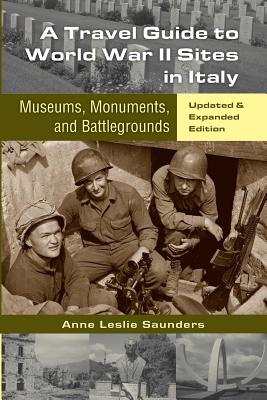A Travel Guide to World War II Sites in Italy: Museums, Monuments, and Battlegrounds

A Travel Guide to World War II Sites in Italy: Museums, Monuments, and Battlegrounds
Amazon sells the first (2010) and second (2016) edition of this book. The author recommends buying the second edition, which begins with a summary of Italy's role in World War II. The following nineteen chapters provide tours of WWII memorials, cemeteries, and museums in a particular area, beginning in Sicily and ending in northern Italy. Directions are given for all 200 sites, as well as addresses and GPS coordinates. To create a personalized map, plug the addresses or coordinates into your cell phone, tablet, or computer. SUMMARY
Chapter 1 describes Italy's role in WWI, the rise of Fascism, and Italy's alliance with Germany during World War II Chapters 2 and 3 focus on museums and memorials honoring American, British, and Canadian troops along Sicily's southern and eastern coasts, where Allied armies landed and began the Italian campaign in 1943. Chapter 4 covers the subsequent landing of Allied forces near Salerno, where the U.S. Fifth Army met stiff resistance from German forces. Numerous monuments and several museums mark those events. Chapter 5 focuses on memorials in and near the city of Cassino, where German forces blocked the Allies from advancing for five months in 1944. Included are war cemeteries, battle monuments, and the rebuilt Abbey of Montecassino, which was destroyed during the war and afterwards rebuilt. Chapter 6 concerns the Allied landings at Anzio and Nettuno, towns an hour south of Rome. Here an American cemetery and two Commonwealth cemeteries honor the thousands who died here or in southern Italy. Chapters 7 and 8 are devoted to World War II sites in Rome. These include the Basilica of San Lorenzo, which was damaged by bombs in 1943 and rebuilt soon after the war. Other locations include an apartment building (now museum) used as a prison during the German occupation, and the Jewish Museum, which has exhibits about the deportation of Roman Jews to concentration camps. Chapters 9--13 describe memorial sites in or near Orvieto, Florence, Lucca, and various mountain villages, as well as selected Gothic Line battlegrounds. The latter have the remains of bunkers and trenches. Noted also are monuments to combat on Battle Mountain, where Allied and German troops clashed for over a week in the fall of 1944. Today the top of the mountain has commemorative plaques and statues. Chapters 14--17 focus on memorials to uni
PRP: 69.67 Lei
Acesta este Pretul Recomandat de Producator. Pretul de vanzare al produsului este afisat mai jos.
62.70Lei
62.70Lei
69.67 LeiLivrare in 2-4 saptamani
Descrierea produsului
Amazon sells the first (2010) and second (2016) edition of this book. The author recommends buying the second edition, which begins with a summary of Italy's role in World War II. The following nineteen chapters provide tours of WWII memorials, cemeteries, and museums in a particular area, beginning in Sicily and ending in northern Italy. Directions are given for all 200 sites, as well as addresses and GPS coordinates. To create a personalized map, plug the addresses or coordinates into your cell phone, tablet, or computer. SUMMARY
Chapter 1 describes Italy's role in WWI, the rise of Fascism, and Italy's alliance with Germany during World War II Chapters 2 and 3 focus on museums and memorials honoring American, British, and Canadian troops along Sicily's southern and eastern coasts, where Allied armies landed and began the Italian campaign in 1943. Chapter 4 covers the subsequent landing of Allied forces near Salerno, where the U.S. Fifth Army met stiff resistance from German forces. Numerous monuments and several museums mark those events. Chapter 5 focuses on memorials in and near the city of Cassino, where German forces blocked the Allies from advancing for five months in 1944. Included are war cemeteries, battle monuments, and the rebuilt Abbey of Montecassino, which was destroyed during the war and afterwards rebuilt. Chapter 6 concerns the Allied landings at Anzio and Nettuno, towns an hour south of Rome. Here an American cemetery and two Commonwealth cemeteries honor the thousands who died here or in southern Italy. Chapters 7 and 8 are devoted to World War II sites in Rome. These include the Basilica of San Lorenzo, which was damaged by bombs in 1943 and rebuilt soon after the war. Other locations include an apartment building (now museum) used as a prison during the German occupation, and the Jewish Museum, which has exhibits about the deportation of Roman Jews to concentration camps. Chapters 9--13 describe memorial sites in or near Orvieto, Florence, Lucca, and various mountain villages, as well as selected Gothic Line battlegrounds. The latter have the remains of bunkers and trenches. Noted also are monuments to combat on Battle Mountain, where Allied and German troops clashed for over a week in the fall of 1944. Today the top of the mountain has commemorative plaques and statues. Chapters 14--17 focus on memorials to uni
Detaliile produsului








